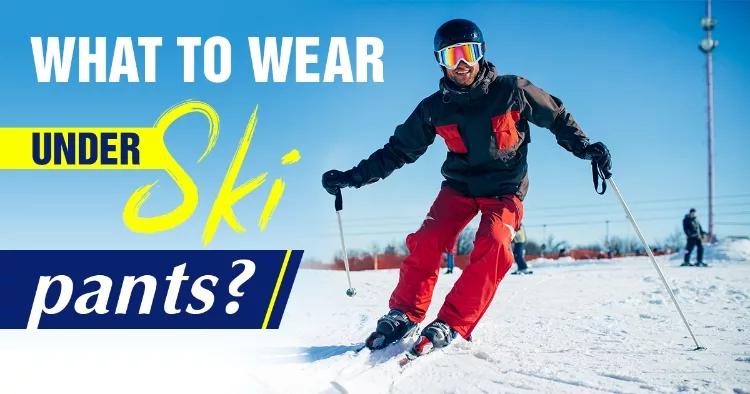What To Wear Under Ski Pants? Careful Planning Is Needed
by Frank V. Persall
What to wear under ski pants depends where you're skiing. In extremely cold climates, you'll probably want to wear thermals, then sweats, then your snow pants. However, if it's not that cold, or if you feel too restricted in that, you could just wear thermals and snow pants.
Contents

To experience maximum adventure from skiing the cold snow-clad slopes that can drench you instantly, you must remain dry and warm as long as possible. This requirement sounds amusingly impossible. Therefore, making it all the more sense why there are garments specifically designed for skiing. And you'll soon discover that even the essential clothes for skiing are water-resistant and insulated to keep you dry and warm.
However, it would be excellent if you remember that the ski jacket and long underwear (pants) for skiing might keep you safe from getting wet in the cold snow outside, but are of no help in absorbing the moisture of your sweat from within. And this is where deciding on what to wear under snow pants comes into play.
The base layer or the long underwear is part of the ski uniform, which everyone should thoughtfully consider, as it determines the level of comfort while skiing. One wrong move and you may even end up questioning the fun in skiing, which is not a pleasant experience. Hence, this article will guide you through the basic dos and don'ts of base layers you will need to keep in mind before planning your first or next ski trip holiday.
What Do You Wear Under Ski Pants?
Remember that everything worn for skiing, from the ski goggles, ski jacket t0 the ski gloves, has been designed to help one ski at ease with protection. This list includes even your underwear. Hence, like every other ski garment, even your base layer is uniquely designed to meet the concerned requirements. Let's consider now, why?
First, let's study the ski pants. They are of two basic types, shell and insulated ski pants. As the name suggests, one acts only as an outer pant while the latter insulates and provides warmth. One quality they share in common is that both the long underwear are water-resistant. So, neither from the outside nor from the inside can they wick any moisture. This quality is a boon and a bane. With nowhere to escape, your sweat will do nothing else but trouble you and cause skin sores.
Upon learning the consequences, you might become cognizant and wear something underneath your ski pants. However, as mentioned earlier, you can't just wear anything. Take, for example, cotton clothes; they will only absorb your sweat and will neither insulate nor dry the moisture quickly. You'll end up feeling cold and uncomfortable. Therefore, it is necessary to wear a base layer that can handle such complications. A good base layer will have these three essential qualities; moisture-wicking, insulated, and last but not least, it can never be cotton. Depending upon the weather condition, whether cold or warm, the base layer can provide more warmth or allow more breathability accordingly.
Quick Tip
With knee-length ski socks, make sure to wear them over the base layer if you want more warmth and a perspiration-free experience.
What Can I Wear If I Don't Have Snow Pants?
While ski pants may be the recommended clothing for skiing, it doesn't suggest that you can't have fun when you ski without them. There are alternative pants which can work half as good as ski pants. Adding on, you'll wear a base layer, which will compensate for most of the inconveniences caused by the substitute pants. Now, let's take a look into the wardrobe and identify the pants that will come to your rescue in such situations.
The pants that have made it to the list are:
- · Wind Pants - These pants are lightweight and water-resistant, which makes them an ideal substitute for ski pants. They are not insulated, so you must take care to wear a base layer and probably even a mid-layer for more warmth.
- · Fleece Pants - These pants provide the warmth you need and are less water-resistant. Most of these pants are only anteriorly fleeced while the outer garment is more suited to function as a water repellent. Hence, making them also a smart choice.
- · Nylon or Polyester Leggings - These comfortable pants have made it to the list because they have both elastic and moisture-wicking properties, which can be used to your advantage when skiing. Further on, the long johns are usually skin fit; hence they wouldn't conflict with the leggings.
Here's a heads up, when choosing clothes to ski, always avoid cotton and denim garments.
What To Wear Under Snow Pants?
Ski pants and pants for snowboarding are pretty much the same. Therefore, you must wear a base layer under both instances. However, the real question is, what type of base layer is ideal for snowboarding? We recommend using a synthetic base layer. And here's why, although ski and snowboarding are almost the same, the latter consumes more physical exercise. Hence, you'll be breaking more sweat. And synthetic base layers are better at wicking away excess sweat! A few of them are also spun in such a way to maximize breathability. Hence, a base layer that provides more moisture absorbent service than warmth is a better choice.
The purpose of a base layer
In simple words, the primary purpose of base layers is to keep you warm, comfortable, and dry, so that you can enjoy skiing to the fullest. But the weather is not always the same; it can get bitter cold or even end up radiating its warmth like never before. You never know. However, one thing you can be confident of is which base layer will suit which weather condition.
The base layers come in two types with different purposes:
- Synthetic - Made from nylon and polyester, these base layers boast of their ability to wick away any amount of moisture produced quickly. The sweat absorbed travels into the base layer, where it will dry up and make sure no liquid is in contact with your skin. All play and no sweat leave the ski holiday with no regret. These features conclude that the purpose of the base layer fulfils more on warmer days. You can even use them for several ski holidays because of their guaranteed durability and flexibility.
- Merino wool - As you can tell from its name, this type of base layer is more suited for colder temperatures. The wool provides the optimum warmth, and despite initial assumptions, it doesn't cause any skin irritation. The best part about these long johns is that they are odour resistant and are quite good at wicking away the sweat. If you want to warm yourself more, you can always choose to wear a mid-layer to keep the cold at bay.
Conclusion
As you plan your first or next ski trip holiday, always remember to carry your second skin (long johns). It will determine whether you're going to have the time of your life or not. And with a base layer kept ready, you don't even have to worry much about the ski pants.
However, if you're going to a frigid cold place, don't forget to add another mid-layer to your second skin. I hope the article has helped you avoid any unforeseen error and always keep in mind; the key to an adventurous ski holiday lies in your skis and your long underwear.
Related Posts:
Beginner's Guide to Skiing In The Rain
 |
 |
 |
 |

About Frank V. Persall
Frank is originally from the UK, but he has a passion for skiing that knows no bounds. He has made it his life's mission to visit the best ski resorts across the USA and the World. Frank loves spending time with his wife and three children on ski slopes, as they all share his love for the activity.
Thoughts on "What To Wear Under Ski Pants? Careful Planning Is Needed"
 |
 |
 |
 |
You can get FREE Gifts. Or latest free skiing books here.
Disable Ad block to reveal all the info. Once done, hit a button below
 |
 |
 |
 |